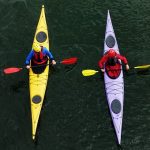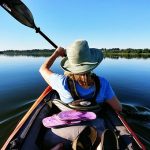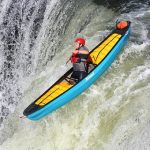SUP and Kayak, which should you pick this weekend?
It’s important to have a good understanding of the different water activities available before trying them out. This way, you can make sure you have all the necessary equipment and knowledge for a safe and enjoyable experience.
I can talk about that anytime. But recently, I’ve been focusing on writing about stand-up paddleboarding and kayaking. So I guess it’s only natural for me to talk about the differences between paddleboarding and kayaking.
To give you some information, I’ll cover the history of each sport, the different types, and the much-awaited breakdown of each sport.
Let’s hop on board, shall we?
Tell Me About these Watersports!
Why are these two sports so popular in the water sports community? There are a number of reasons. But first, let’s look at how they started.
Okay, Let’s Start with Paddleboarding
The following is a paraphrased version of the text. Here’s the thing, SUP was born from surfing in Hawaii. People do it by standing on boards that float on water and steering them with paddles. You can use SUPs for a lot of things such as fishing, yoga, surfing, and more!
The best part about surfing is that it didn’t originate in Hawaii and wasn’t solely for recreation.
The activity of SUP fishing started 3000 years ago. The Peruvians used a Caballitos de Totora, which is a reed woven object, and a bamboo paddle to fish.
Back when Captain James Cook discovered surfing as one of the cores of Hawaiian Polynesian culture, their Chief owned the best board and paddle because he was the best wave rider in the land.
In the 1950s, the practice of taking photographs of surf students while they were surfing became popular in Waikiki. Duke Kahanamoku, Leroy, and Bobby Ah Choy were looking for a way to take such photographs, and they found a solution thanks to John “Pops” Ah Choy, who was relaxing on an oversized surfboard with a paddle.
The big boom mentioned is the popularity of surfing, which increased dramatically during the early 21st century. This is largely thanks to the photographs of Dave Kalama and Laird Hamilton surfing in Maui, which showed how much fun surfing can be.
I recommend that you try all the different types of SUPs. You won’t regret it!
How about Kayaking?
Ah, kayaking. Surely another fun watersport! You skim the water in a small vessel using a double-bladed paddle, sitting with your legs straight and under a closed deck, leaving much of the work to your exposed upper body.
The kayak originated with the Inuit, Yup’ik, and Aleut. These boats were used for hunting in nearby waters. These vessels were made from stitched animal skins stretched over wood or whalebone.
Kayaking was created thousands of years ago and is still practiced today. The word “kayak” means “man’s boat” or “hunter’s boat” in Inuit. These boats were customized by each man and his wife and were used for fishing, hunting and transporting people and goods.
The Russian explorers in the 1740s exploited and kidnapped Aleutians to work and hunt. They took both the indigenous people’s kayaks for hunting and transportation and the indigenous people’s freedom. It was quite a dark time.
Adolf Anderie was the first person to kayak down Salzachöfen Gorge, which is now known to be the birthplace of modern whitewater kayaking. A few years later, kayaking was introduced as an event in the Berlin Olympic Games. By the 1970s, kayaking had become a mainstream sport.
Now, there are several different types of kayaking to choose from – recreational, sport, and sea kayaking! You should try all of them out when you have the chance! Each type provides a unique experience that you won’t want to miss!
There are three main types of kayaking: recreational, sport, and sea. Make sure to try all of them to get the full experience!
There are both inflatable and stable versions of SUPs just as there are kayaks. Today’s kayaks are strong and durable.
Which Is Easier: Kayaking or Paddle Boarding?
Both stand-up paddle boarding and kayaking are easy and gentle exercises that anyone can do regardless of age or fitness level. Basic skills can be mastered quickly.
You can make your exercise easy or difficult, depending on what you want. If you want something easy and relaxing, you can paddle recreationally. If you want something more intense, you can paddle whitewater. You can do both of these on a SUP or kayak.
Stand Up Paddle Boards vs Kayaks: Honest Comparison
There are key differences between kayaking and SUPing that you should understand before deciding which one is right for you.
How Stable Is It?
Kayaks have a lower center of gravity than canoes, meaning they are more stable. In other words, the higher you are from the ground, the less stable you are.
If you have any problems with balancing and/or stability, you should keep this in mind when choosing between a kayak and a canoe.
Getting Back on
I’ve fallen in so many times at this point that I’ve lost count. It happens every time I go kayaking or paddleboarding, but getting back on afterwards feels different depending on the sport.
It is harder to flip a SUP than a kayak because you do not have a lip to climb over. You can just hop onto the SUP easily. There is not much trouble in pulling yourself up. The next thing you know you’re kneeling, standing up, then paddling on again.
An ankle leash is also a bonus because it won’t float that far away when you wipe it out.
Even though kayaks are narrower and can tip over more easily, with a little practice you will be able to flip them back over and climb back in. Keep trying and you will get it!
Portability
Stand-up paddle boards are more compact and easier to transport than kayaks.
If you decide to buy a kayak, you will need more storage space. This means that it is not a good option for people who live in small apartments. Even though you have storage space, carrying the kayak to and from the water or in and out of storage each time you use it is quite the task, because kayaks are heavy.
A SUP board is smaller and more compact, making it easier to handle. You don’t need large storage space for it. If your SUP board is gorgeous, you can buy a storage rack and display it on a wall in your home.
Paddle boards are easier to transport than kayaks. One person can lift a paddle board onto the roof of a car without issues while it takes much more effort to lift a kayak to that level. Some kayaks weigh over 100 pounds!
When the topic of conversation shifts to inflatable kayaks versus inflatable stand-up paddleboards (SUPs), both of which can be deflated and stored in smaller packages, people tend to have strong opinions.
If you’re worried about being able to transport and carry your SUP, don’t worry. SUPs are much lighter and easier to handle, making them more convenient to carry. Plus, if you want, you can always get an inflatable SUP.
With an inflatable SUP, you can deflate it into a small size and squeeze it into a handy carrying bag.
Kayaks also come in inflatable options which are much more convenient for transport and storage purposes. However, these kayaks generally don’t perform as well as the rigid ones. Do your research to find the best option for you.
Winner: stand up paddle board
Comfort
One’s preference determines whether to kayak paddle from a sitting or standing position.
Sitting in a kayak is more comfortable for long kayaking trips, especially if you have a seat with good padding and back support. Sit-in kayaks can be more restrictive in terms of movement, but as long as the kayak is the right size and you have enough legroom, you should be comfortable.
Sit-on-top kayaks provide more room to move around, and some are very stable, so you can even stand up and stretch your legs.
Standing on a SUP for hours can be exhausting. Even though you can kneel, sit, and paddle in the prone position, it is not as comfortable as a kayak.
Winner: Kayak
Cost of Getting Started
One of the similarities between kayaks and SUP boards is their price range.
Some SUPs and kayaks cost very little while the high-end ones go for a lot.
Cheaper SUP boards and kayaks are great for beginners, while more expensive models tend to have more features and be designed for specific activities.
You can find inflatable kayaks and paddle boards for cheap, even if you’re on a budget. You’ll have more options if you decide to spend more and get a nicer model. Most paddle boards and kayaks come with the accessories you need to get started.
So there’s no winner here.
Gear Storage
You’ll need to bring some essential supplies and gear with you on your next SUP or kayak trip. The duration of your trip will determine how much you’ll need to bring.
Tours lasting the whole day don’t need a lot of equipment and you can use either a kayak or SUP board. SUP boards usually have bungee tie-downs at the front and back so you can carry a couple of bags and a cooler box.
For long journeys and excursions, you will need to bring a lot of stuff with you. Most kayaks have different storage options on board so you can bring more gear. For example, sea kayaks have dry hatches and bungee tie-downs, and there is more room inside the cockpit.
You would be surprised at how much camping gear you can fit into a kayak.
Another advantage to kayak storage is that you can keep some of your gear dry, by storing them in the dry hatches. Paddle Boards don’t have dry hatches, and water will splash all over your stuff– unless you use waterproof dry bags.
Winner: Kayak
Paddling in Warm Weather
Sit-inside kayaks have a cockpit for you to sit in with your lower body. The cockpit is not big, so your movement is restricted. This is not desirable in hot weather.
It wouldn’t be fun to be stuck in a small cockpit in the summer heat. You would want to jump in for a quick swim, but getting out of the cockpit and back in would be too much trouble.
Paddle boarding is unique because your entire body is visible and you can feel the refreshing ocean wind while having more flexibility to move. Additionally, it’s easy to jump off the SUP to go for a swim and then get back on.
If you’d rather relax, you can lay on your paddle board and soak up some sun as you float around.
Winner: stand up paddle board




